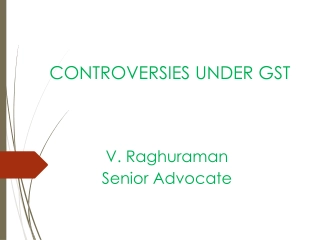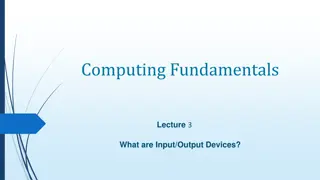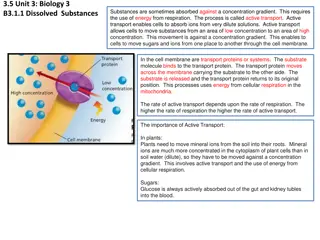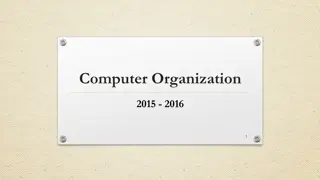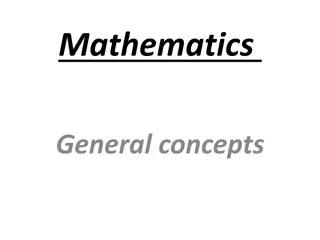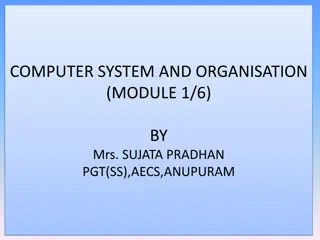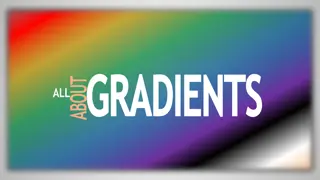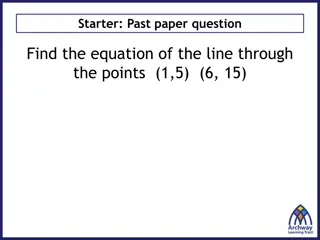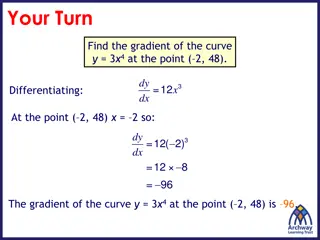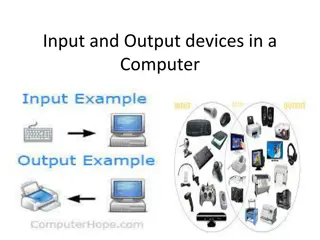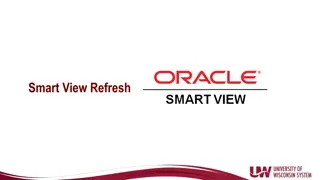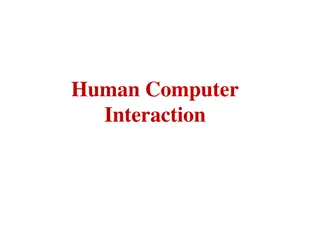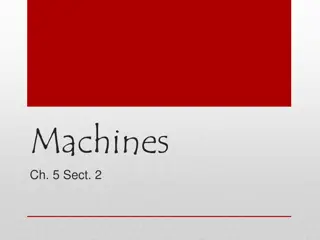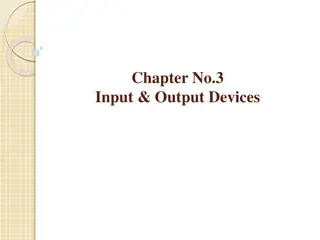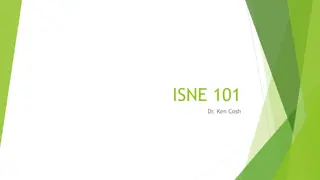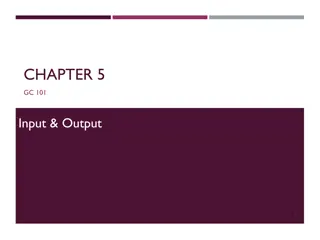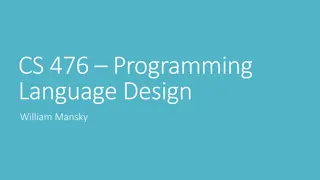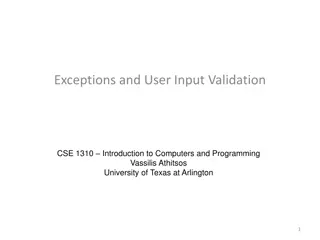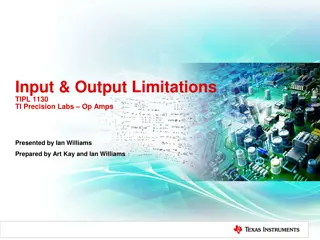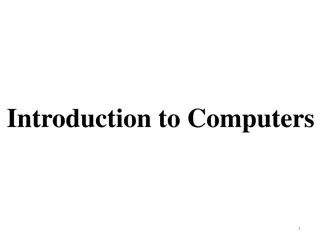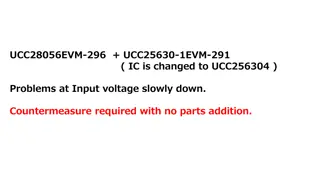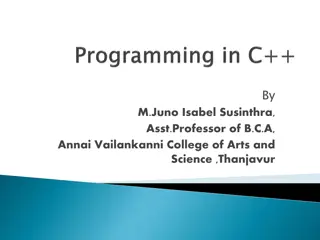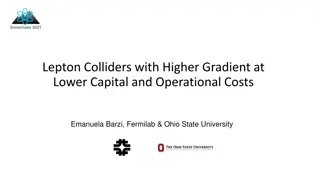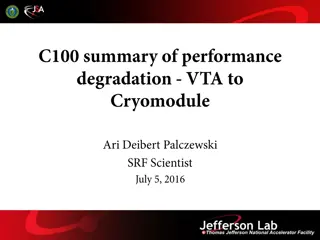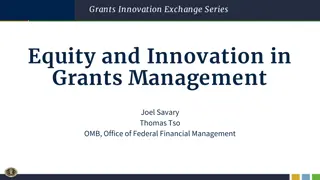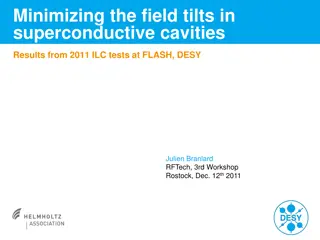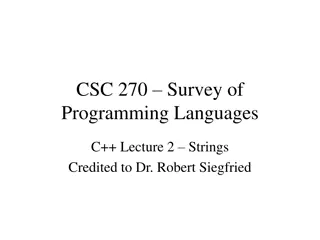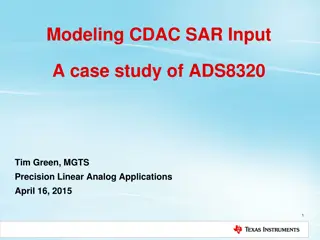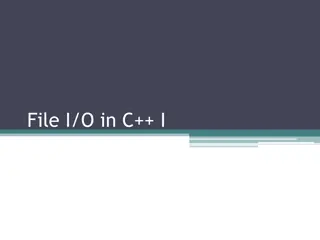GST Controversies and Input Tax Credit Issues
Explore controversies under GST related to input tax credit issues. Learn about recent cases involving reversal of credits, buyer responsibilities, and legal implications for buyers and sellers. Understand the complexities of availing input tax credits under GST.
5 views • 93 slides
Input-Output Models in Economics
Input-Output models, pioneered by Wassily Leontief, depict inter-industry relationships within an economy. These models analyze the dependencies between different sectors and have been utilized for studying agricultural production distribution, economic development planning, and impact analysis of i
8 views • 7 slides
Do Input Gradients Highlight Discriminative Features?
Instance-specific explanations of model predictions through input gradients are explored in this study. The key contributions include a novel evaluation framework, DiffROAR, to assess the impact of input gradient magnitudes on predictions. The study challenges Assumption (A) and delves into feature
0 views • 32 slides
Input and Output Devices in Computing
In computing, input and output devices play a crucial role in enabling communication between users and computers. Input devices are used to enter data into a computer, while output devices display or provide the results of processed information. Common input devices include keyboards, mice, and joys
1 views • 17 slides
Active Transport and Osmosis in Biology
Substances can be absorbed against concentration gradients through active transport, requiring energy from respiration. Cells use transport proteins to move substances across membranes. Osmosis involves the movement of water across a selectively permeable membrane along concentration gradients. The
4 views • 12 slides
Basic Input/Output Operations in Computer Organization
Basic Input/Output Operations are essential functions in computer systems that involve transferring data between processors and external devices like keyboards and displays. This task requires synchronization mechanisms due to differences in processing speeds. The process involves reading characters
0 views • 11 slides
Functions and Graphs in Mathematics
Functions are a fundamental concept in mathematics used to describe relationships in the real world. They can be represented through equations, graphs, tables, or verbal descriptions. A function maps elements from a domain to a range, where each input has a unique output. The domain encompasses all
0 views • 4 slides
Computer System and Organization
Computer Organization involves the logical structure of a computer, defining the interconnections of components for optimal performance. Computers process data through an Input-Process-Output cycle, with input, processing, and output units working together. The characteristics of a computer include
2 views • 20 slides
A Comprehensive Guide to Gradients
Gradients are versatile tools in design, allowing shapes to transition smoothly between colors. Learn about gradient types, preset options, creating your own metallic gradients, and applying gradients effectively in this detailed guide. Explore linear and radial gradient directions, understand gradi
0 views • 7 slides
Rates of Change and Calculus Concepts
Exploring the concept of rates of change through examples like finding the equation of a line passing through given points and understanding differentiation to calculate gradients and speeds. The relationship between gradients, curves, and tangents is highlighted to illustrate how calculus helps in
1 views • 21 slides
Calculus Examples and Practice
Explore various calculus problems involving finding gradients, equations of tangents and normals, and analyzing curves. Practice determining gradients at specific points, solving for coordinates, and differentiating equations to find tangent and normal lines. Understand the relationship between grad
1 views • 11 slides
Input and Output Devices in a Computer
Input devices play a crucial role in sending data to a computer, allowing users to communicate instructions for processing, display, storage, and transmission. Key input devices include keyboards and mice, each serving specific functions and enhancing data collection and accuracy. Discover the advan
0 views • 17 slides
Using Smart View in PlanUW: Data Input and Reporting
Learn how to efficiently input data and build reports in PlanUW using Smart View. Discover the differences between data input forms and Ad Hoc grids, understand when to use each, and explore the steps involved in entering data via Ad Hoc. Find out how to open forms and reports in Smart View, as well
1 views • 6 slides
Human-Computer Interaction and Input Devices
Human-Computer Interaction involves the interaction between users and computers, exploring various input devices such as keyboards, handwriting recognition, and pointing devices. Learn about the evolution from batch data entry to modern forms of interaction, including speech recognition and stylus i
0 views • 12 slides
Machines: Work, Forces, and Efficiency
Machines play a vital role in making work easier by increasing force, distance, or changing the direction of applied force. Different types of machines like levers, pulleys, and inclined planes simplify work processes. Understanding input and output forces, as well as input and output work, is essen
2 views • 10 slides
Overview of Computer Input and Output Devices
Input devices of a computer system consist of external components like keyboard, mouse, light pen, joystick, scanner, microphone, and more, that provide information and instructions to the computer. On the other hand, output devices transfer information from the computer's CPU to the user through de
0 views • 11 slides
Input and Output Devices in Computers
Input devices like keyboards, mice, joysticks, light pens, scanners, and more play a crucial role in interacting with computers. This chapter explores the functions and features of various input devices used in computing, such as keyboards for data input, mice for cursor control, and joysticks for C
1 views • 12 slides
Evolution of Input Devices in Information Systems
Explore the evolution of input devices in information systems, from early punched cards to modern touch-based and gesture interactions. Learn about the legacy of typewriters, the development of keyboards and mice, and the emergence of mobile input technologies. Discover how technology has advanced t
0 views • 43 slides
Social Gradients in Health and Socioeconomic Status
This presentation delves into the complexities of social gradients in health and socioeconomic status, highlighting the impact of indicators such as employment status, education, poverty, and housing tenure. It emphasizes the need to reassess indicators used for determining socioeconomic status and
2 views • 7 slides
Interactive Programs and Input/Output in Java
Interactive programs in Java allow users to input data through the console, which can be captured and used in the program. This involves using the Scanner class to read user input, and understanding common Scanner methods to process different types of input. Importing Java class libraries is essenti
2 views • 15 slides
Input and Output in Programming: A Comprehensive Guide
This content provides detailed explanations and examples on input and output handling in programming, focusing on concepts such as I/O as State, typed output, and consuming input lists. It covers topics like using print statements, scanning inputs, and building output lists in programming languages.
1 views • 44 slides
Input Validation in Java Programming: Handling Exceptions and User Input
Learn how to implement input validation in Java programming to prevent crashes when users provide invalid input. Explore strategies for handling exceptions like InputMismatchException and the importance of reading strings directly from user input. Discover methods for converting strings to numbers a
2 views • 33 slides
Mineral Absorption in Plants: Mechanisms and Types
Plants absorb minerals from the soil as ions through the roots, with the process of mineral absorption being distinct from water absorption. Mineral absorption in plants can occur through passive or active methods, each involving different mechanisms and energy requirements. Passive absorption is a
0 views • 14 slides
Input and Output Limitations in Op Amps
Explore the various input and output limitations in TI Precision Labs Op Amps as presented by Ian Williams and prepared by Art Kay and Ian Williams. Delve into common mode voltage, voltage swing, data sheet parameters translation, input and output stages, examples of common mode voltage, and potenti
0 views • 15 slides
Scanner Class in Java: Reading User Input and Processing Files
The Scanner class in Java's java.util package allows reading input from the keyboard or files. It looks for tokens in the input, reads different types of values, and has methods like nextInt() and nextLine(). You can also read from files by creating a File object. Learn how to use Scanner to interac
0 views • 21 slides
Introduction to Computers: Understanding Hardware and Input Devices
Computers are electronic devices that process input to produce information. They consist of hardware components like CPUs, input/output units, and memory. Input devices such as keyboards, mice, and scanners help translate human-readable data for computer processing.
0 views • 11 slides
Active Transport of Molecules: Driven by ATP Hydrolysis
Active transport, fueled by ATP hydrolysis, facilitates the movement of molecules against their concentration gradients, essential for processes like ion pumping across membranes. The Na+-K+ pump, a prime example, utilizes ATP to transport Na+ and K+ ions across cellular membranes, maintaining impor
0 views • 23 slides
Troubleshooting AC Input Voltage Variations in UCC28056EVM-296 and UCC25630-1EVM-291
Addressing issues with input voltage fluctuations in UCC28056EVM-296 and UCC25630-1EVM-291, where the voltage slowly decreases under different load conditions. Problems include output stopping at varying AC voltages based on load and hunching behavior at different load levels. Countermeasures are ne
0 views • 7 slides
C++ Streams and I/O Operations
C++ streams play a crucial role in handling input/output operations by linking logical devices to physical ones. They provide a uniform interface for programmers to work with various devices efficiently. This article covers the basics of C++ streams, input/output streams, common functionalities like
0 views • 17 slides
Advancements in Lepton Colliders Technology
Emanuela Barzi and co-authors have made significant progress in developing lepton colliders with higher gradients at lower capital and operational costs. Their research focuses on using Superconducting Nb3Sn coated Cu RF cavities, parallel-feed RF structures, and innovative technologies to achieve h
0 views • 9 slides
Quality Control and Testing Procedures for Superconducting Radiofrequency Cavities
The presentation highlights the rigorous processes involved in qualifying superconducting radiofrequency (SRF) cavities for high-performance applications. Each cavity undergoes a detailed qualification process, including BCP treatment, electropolishing, and high-pressure rinsing, to ensure optimal p
0 views • 18 slides
Opportunities for Feedback and Input on Government Programs
The Office of Management and Budget (OMB) and various agencies are seeking public input through Requests for Information (RFIs) on advancing equity and support for underserved communities. Examples include input on USDA programs, FEMA policies, National Library of Medicine opportunities, and more. P
0 views • 8 slides
Minimizing Field Tilts in Superconductive Cavities: 2011 ILC Tests at FLASH
Understanding the importance of achieving flat gradients in superconductive cavities, the 2011 ILC tests at FLASH led by Julien Branlard focused on minimizing field tilts. Various solutions and test approaches were explored to address the issue, with results indicating the impact of cavity tilt and
0 views • 25 slides
Introduction to C++ Programming: Strings and Predefined Functions
This lecture covers essential concepts and functions related to strings in C++, including predefined functions in
0 views • 49 slides
Advancements in Superconducting Linear Colliders for ILC Energy Upgrades
Discussion on higher gradient expectations for SRF at the International Linear Collider (ILC) for energy upgrades beyond 3 TeV, highlighting advancements in single and multi-cell cavity gradients over three decades. Promising R&D paths include cold electropolishing, nitrogen infusion, advanced cavit
0 views • 15 slides
Modeling CDAC SAR Input: A Case Study of ADS8320
This case study delves into modeling the SAR input of ADS8320, exploring the number of time constants vs. ADC resolution, voltage-controlled switches in SPICE, and the correct parameters for modeling SAR ADC. It also covers the specifications of ADS8320, including analog input characteristics, sampl
0 views • 22 slides
File Input/Output (I/O) in C++
File Input/Output (I/O) is an essential concept in C++ programming, allowing for interaction with files stored on secondary storage devices. This involves steps like including the fstream header file, declaring file stream variables, associating them with input/output sources, opening the file, perf
0 views • 19 slides
Input/Output Devices in Computing
An input/output device, also known as an IO device, facilitates interaction between a computer and users or other systems. These devices enable data input and output, enhancing user experience and system functionality. Key input devices like keyboards, mice, and joysticks play vital roles in data en
0 views • 18 slides
Basics of Computer
Computer is an electronic device that accepts input data, processes it, produces output, and stores results. Major components include input unit, output unit, and system unit with CPU, ALU, CU, input, output, and memory. The CPU is the brain of the computer, responsible for major calculations and op
0 views • 18 slides
Thermocouple formation on PC Boards
Thermocouples play a crucial role in measuring temperature gradients on PCBs. Learn about the Seebeck effect, thermocouple theory, junctions of dissimilar conductors, and testing techniques using precision amplifiers. Understand how temperature gradients create thermoelectric voltages and the practi
0 views • 14 slides
